Experimental Study of Injection–Production Coupling Technique for Enhanced Oil Recovery in Mature Water Flooding Reservoirs
Abstract
1. Introduction
2. Experimental Method
2.1. Materials
2.2. Methods
2.2.1. The Transparent Heterogeneous Sand Pack Flooding Test
2.2.2. The Micro-Model Flooding Test
3. Results and Discussion
3.1. Oil–Water Distribution Characteristic Under Conventional Injection–Production Mode
3.1.1. The Remaining Oil Distribution Characteristic
3.1.2. The Incremental Oil Recovery Analysis
3.2. Oil–Water Distribution Characteristics Under Coupled Injection–Production Mode
3.2.1. Effect of Coupled Injection–Production Well Pattern
3.2.2. Effect of Coupled Injection–Production Mode
3.3. Micro-Model Flooding Results
4. Conclusions
Author Contributions
Funding
Data Availability Statement
Acknowledgments
Conflicts of Interest
References
- Alsofi, A.M.; Blunt, M.J. Polymer flooding design and optimization under economic uncertainty. J. Pet. Sci. Eng. 2014, 124, 46–59. [Google Scholar] [CrossRef]
- Liao, G.; Wang, Q.; Wang, H.; Liu, W.D.; Wang, Z. Chemical flooding development status and prospect. Acta Pet. Sin 2017, 38, 196–207. [Google Scholar]
- Sheng, J.J.; Leonhardt, B.; Azri, N. Status of polymer-flooding technology. J. Can. Pet. Technol. 2015, 54, 116–126. [Google Scholar] [CrossRef]
- Kamal, M.S.; Sultan, A.S.; Al-Mubaiyedh, U.A.; Hussein, I.A. Review on polymer flooding: Rheology, adsorption, stability, and field applications of various polymer systems. Polym. Rev. 2015, 55, 491–530. [Google Scholar] [CrossRef]
- Wang, D.; Seright, R.S.; Shao, Z.; Wang, J. Key aspects of project design for polymer flooding at the Daqing Oilfield. SPE Reserv. Eval. Eng. 2008, 11, 1–117. [Google Scholar] [CrossRef]
- Wang, H.; Cao, X.; Zhang, J.; Zhang, A. Development and application of dilute surfactant–polymer flooding system for Shengli oilfield. J. Pet. Sci. Eng. 2009, 65, 45–50. [Google Scholar]
- Li, Z.; Zhang, A.; Cui, X.; Li, Z.; Guo, L.; Shan, L. A successful pilot of dilute surfactant-polymer flooding in Shengli oilfield. SPE 154034. In Proceedings of the SPE Improved Oil Recovery Symposium, Tulsa, OK, USA, 14–18 April 2012. [Google Scholar]
- Kamal, M.S.; Shakil, S.M.; Sultan, A.S. Development of novel amidosulfobetaine surfactant–polymer systems for EOR applications. J. Surfactants Deterg. 2016, 19, 989–997. [Google Scholar] [CrossRef]
- Guo, H.; Wang, Z. Lessons Learned from Surfactant-Polymer Flooding Field Tests in China. SPE 187571. In Proceedings of the SPE Kuwait Oil & Gas Show and Conference, Kuwait City, Kuwait, 15–18 October 2017. [Google Scholar]
- Liu, Z.; Cheng, H.; Li, Y.; Li, Y.; Chen, X.; Zhuang, Y. Experimental Investigation of Synergy of Components in Surfactant/Polymer Flooding Using Three-Dimensional Core Model. Transp. Porous Media 2019, 126, 317–335. [Google Scholar] [CrossRef]
- Sharma, H.; Panthi, K.; Mohanty, K.K. Surfactant-less alkali-cosolvent-polymer floods for an acidic crude oil. Fuel 2018, 215, 484–491. [Google Scholar] [CrossRef]
- Ding, L.; Wu, Q.; Zhang, L.; Guérillot, D. Application of fractional flow theory for analytical modeling of surfactant flooding, polymer flooding, and surfactant/polymer flooding for chemical enhanced oil recovery. Water 2020, 12, 2195. [Google Scholar] [CrossRef]
- Hassan, A.M.; Al-Shalabi, E.W.; Alameri, W.; Kamal, M.S.; Patil, S.; Hussain, S.M.S. Manifestations of surfactant-polymer flooding for successful field applications in carbonates under harsh conditions: A comprehensive review. J. Pet. Sci. Eng. 2023, 220, 111243. [Google Scholar] [CrossRef]
- Ahmed, M.E.; Sultan, A.S.; Al-Sofi, A.; Al-Hashim, H.S. Optimization of surfactant-polymer flooding for enhanced oil recovery. J. Pet. Explor. Prod. Technol. 2023, 13, 2109–2123. [Google Scholar] [CrossRef]
- Alhotan, M.M.; Batista Fernandes, B.R.; Delshad, M.; Sepehrnoori, K.A. Systemic Comparison of Physical Models for Simulating Surfactant–Polymer Flooding. Energies 2023, 16, 5702. [Google Scholar] [CrossRef]
- Wu, D.; Zhou, K.; Hou, J.; An, Z.; Zhai, M.; Liu, W. Experimental study on combining heterogeneous phase composite flooding and streamline adjustment to improve oil recovery in heterogeneous reservoirs. J. Pet. Sci. Eng. 2020, 194, 107478. [Google Scholar] [CrossRef]
- Liu, W.; He, H.; Yuan, F.; Liu, H.; Zhao, F.; Liu, H.; Luo, G. Influence of the injection scheme on the enhanced oil recovery ability of heterogeneous phase combination flooding in mature waterflooded reservoirs. ACS Omega 2022, 7, 23511–23520. [Google Scholar] [CrossRef] [PubMed]
- He, H.; Liu, W.; Chen, Y.; Liu, H.; Liu, H.; Luo, G. Synergistic mechanism of well pattern adjustment and heterogeneous phase combined flooding on enhancing oil recovery in mature fault-block reservoirs. J. Pet. Explor. Prod. Technol. 2022, 12, 3387–3398. [Google Scholar] [CrossRef]
- Du, Q.J.; Pan, G.M.; Hou, J.; Guo, L.L.; Wang, R.R.; Xia, Z.Z.; Zhou, K. Study of the mechanisms of streamline-adjustment-assisted heterogeneous combination flooding for enhanced oil recovery for post-polymer-flooded reservoirs. Pet. Sci. 2019, 16, 606–618. [Google Scholar] [CrossRef]
- He, H.; Fu, J.; Hou, B.; Yuan, F.; Guo, L.; Li, Z.; You, Q. Investigation of injection strategy of branched-preformed particle gel/polymer/surfactant for enhanced oil recovery after polymer flooding in heterogeneous reservoirs. Energies 2018, 11, 1950. [Google Scholar] [CrossRef]
- Zhang, L.; Sun, T.; Han, X.; Shi, J.; Zhang, J.; Tang, H.; Yu, H. Feasibility of advanced CO2 injection and well pattern adjustment to improve oil recovery and CO2 storage in tight-oil reservoirs. Processes 2023, 11, 3104. [Google Scholar] [CrossRef]
- Boah, E.A.; Kondo, O.K.S.; Borsah, A.A.; Brantson, E.T. Critical evaluation of infill well placement and optimization of well spacing using the particle swarm algorithm. J. Pet. Explor. Prod. Technol. 2019, 9, 3113–3133. [Google Scholar] [CrossRef]
- Arinkoola, A.O.; Onuh, H.M.; Ogbe, D.O. Quantifying uncertainty in infill well placement using numerical simulation and experimental design: Case study. J. Pet. Explor. Prod. Technol. 2016, 6, 201–215. [Google Scholar] [CrossRef]
- Gao, C.; Gray, K.E. A workflow for infill well design: Wellbore stability analysis through a coupled geomechanics and reservoir simulator. J. Pet. Sci. Eng. 2019, 176, 279–290. [Google Scholar] [CrossRef]
- Fang, Y.; Yang, E.; Yin, D.; Gan, Y. Study on distribution characteristics of microscopic residual oil in low permeability reservoirs. J. Dispers. Sci. Technol. 2019, 41, 1–10. [Google Scholar] [CrossRef]
- Hong, C.Y.; Yang, R.Y.; Huang, Z.W.; Zhuang, X.Y.; Wen, H.T.; Hu, X.L. Enhance liquid nitrogen fracturing performance on hot dry rock by cyclic injection. Pet. Sci. 2023, 20, 951–972. [Google Scholar] [CrossRef]
- Stirpe, M.T.; Guzman, J.; Manrique, E. Cyclic Water Injection Simulations for Evaluations of its Potential in Lagocinco Field. In Proceedings of the SPE/DOE Fourteenth Symposium on Improved Oil Recovery, Tulsa, OK, USA, 17–21 April 2004; pp. 1–16. [Google Scholar]
- Wang, X.; Wang, J. Laboratory study on unsteady water in jection for stra tified he terogeneous reservoirs. Spec. Oil Gas Reserv. 2009, 4, 8–67. [Google Scholar]
- Wang, G. Unstable Water Injection Experiment and Parameters Optimization Design in Heterogeneity Reservoir. Master’s Thesis, Yanshan University, Qinhuangdao, China, 2011. [Google Scholar]
- Xu, S.; Yue, P.; Liu, M.; Huang, Y.; Lin, B. Injection-Production Coupling Technique for Improving the Development Performance of Structural—Lithological Reservoir. Spec. Oil Gas Reserv. 2016, 23, 110–112. [Google Scholar]
- Xie, W.; Shi, L.; Lv, Y.; Zeng, J.; Wang, J.; Zhang, L. Cyclic Waterflooding Scheme for Heterogeneous Reservoir of Ultra-low Permeability. Unconventonal Oil Gas 2016, 3, 47–52. [Google Scholar]
- Gan, H.; Zhang, C.; Jia, S.; Yu, X.; Zhang, Z. Numerical Simulation Study on Optimization of Injection-Production Coupling Parameters in Complex Fault Block Reservoirs. Acad. J. Sci. Technol. 2023, 8, 206–211. [Google Scholar] [CrossRef]
- Sun, L.; Cui, C.; Wu, Z.; Yang, Y.; Zhang, C.; Wang, J.; Guevara, J. A mathematical model of CO2 miscible front migration in tight reservoirs with injection-production coupling technology. Geoenergy Sci. Eng. 2023, 221, 211376. [Google Scholar] [CrossRef]
- Lin, C.; Jia, X.; Deng, S.; Mao, J.; Chen, X.; He, J.; Li, X. The Roles of Micro Pores and Minerals in Shale during Hydraulic Fracturing. Rock Mech. Rock Eng. 2024, 57, 10177–10186. [Google Scholar] [CrossRef]
- Lin, C.; Deng, S.; Mao, J.; Jiang, Z.; Chen, X.; Yang, X.; Zhang, Y.; He, J.; Li, Y.; Zhen, C. A New Brittleness Evaluation Index for Reservoir Rocks Based on Fuzzy Analytic Hierarchy Process and Energy Dissipation. SPE J. 2024, 29, 5272–5285. [Google Scholar] [CrossRef]
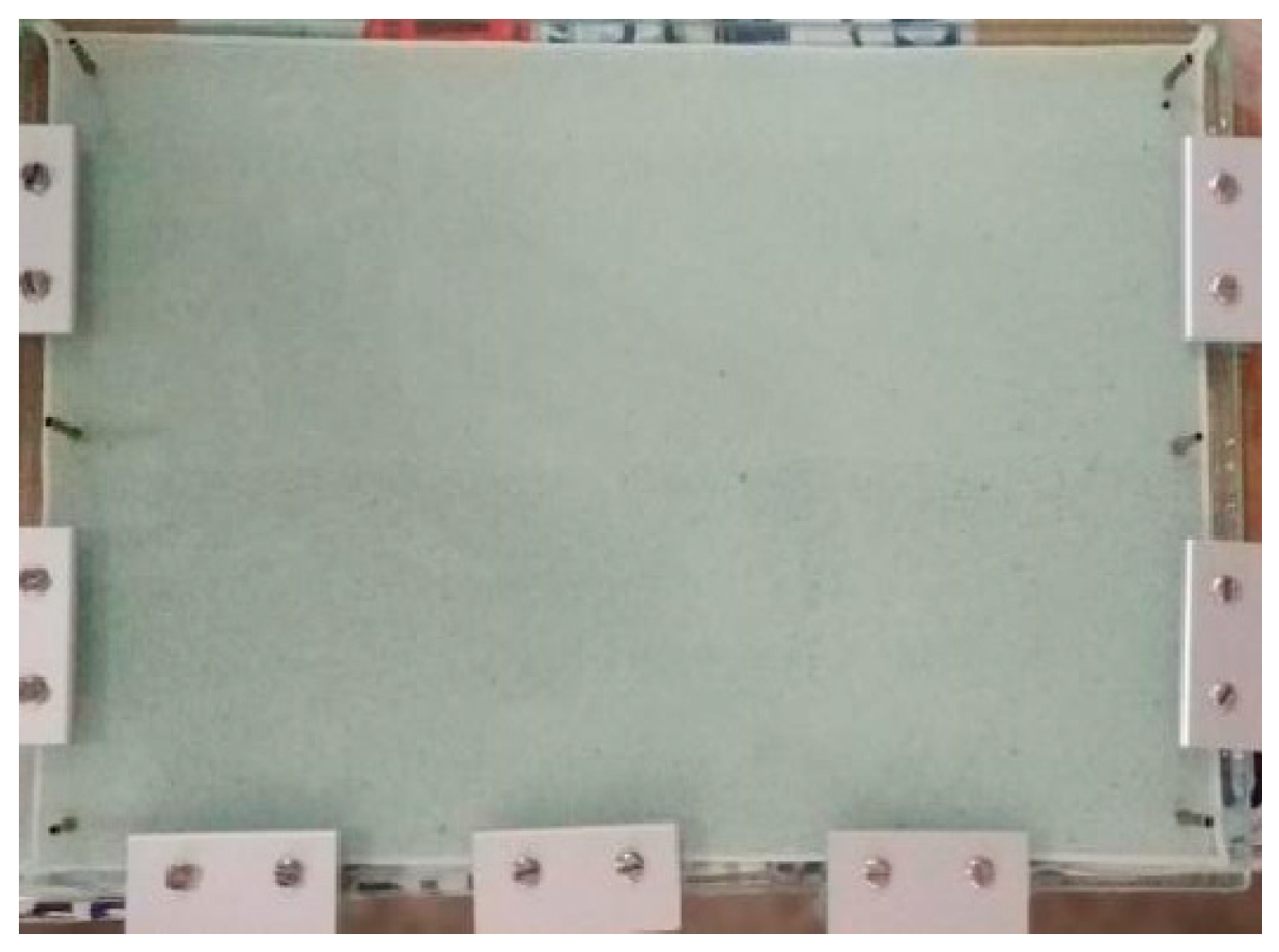
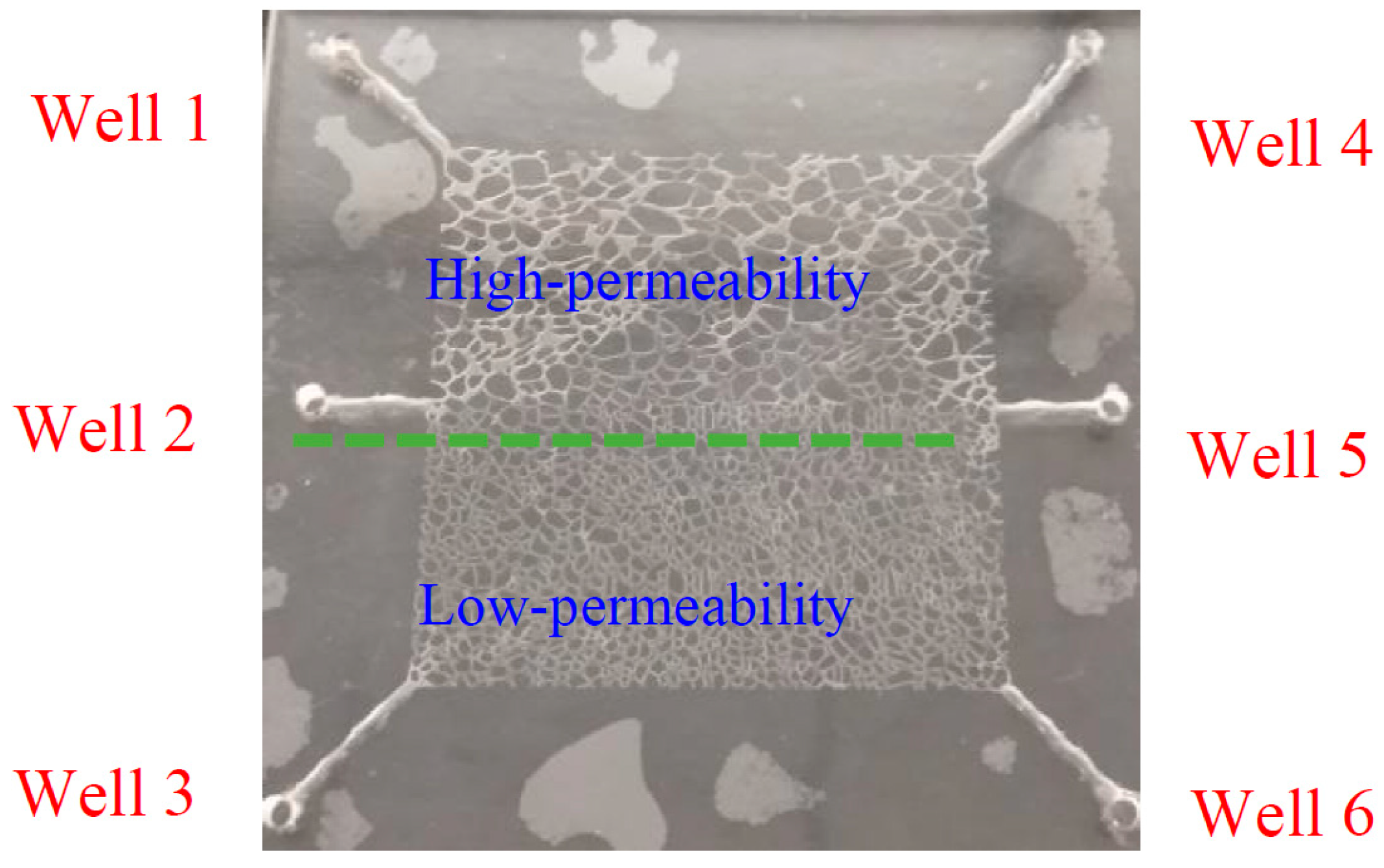
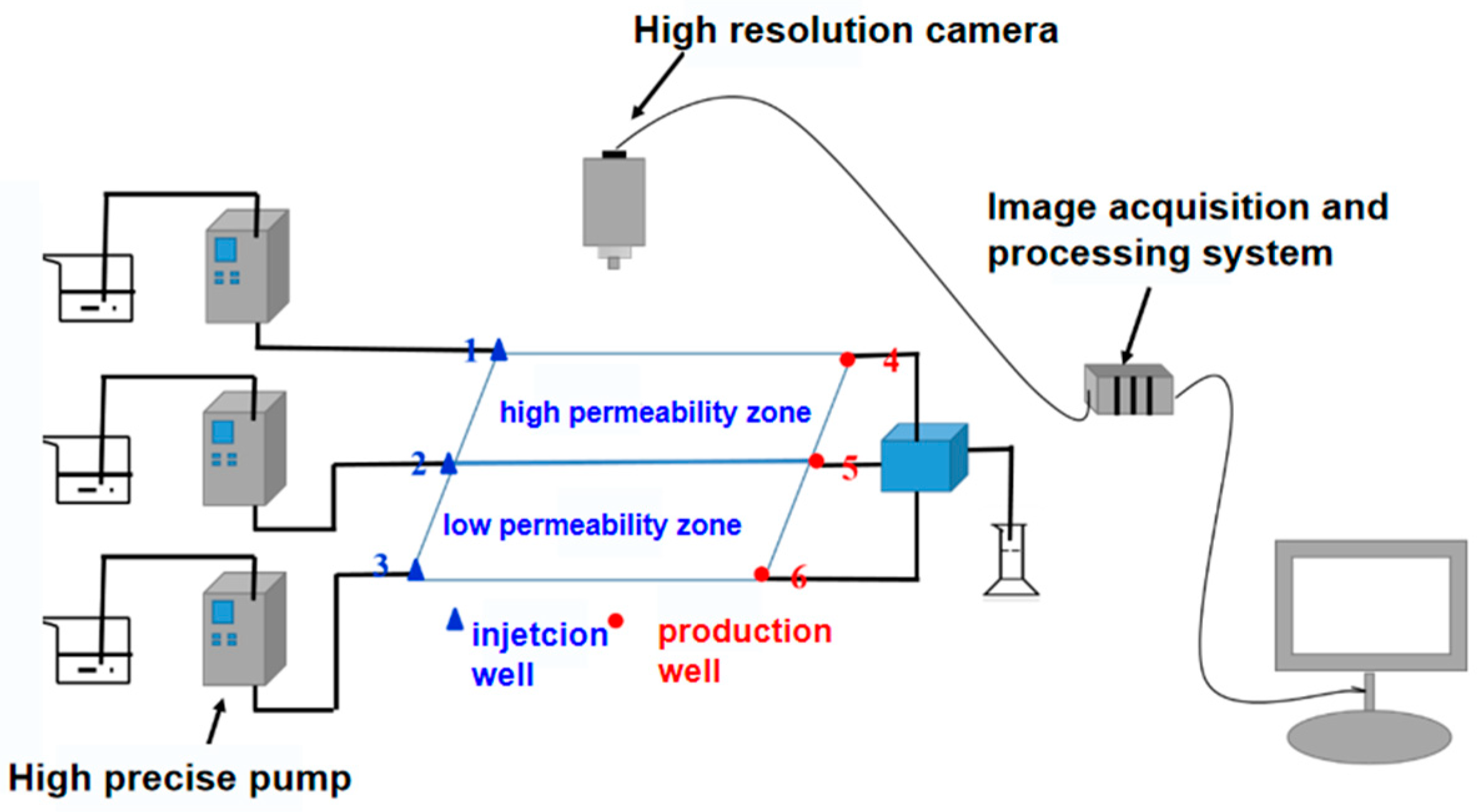
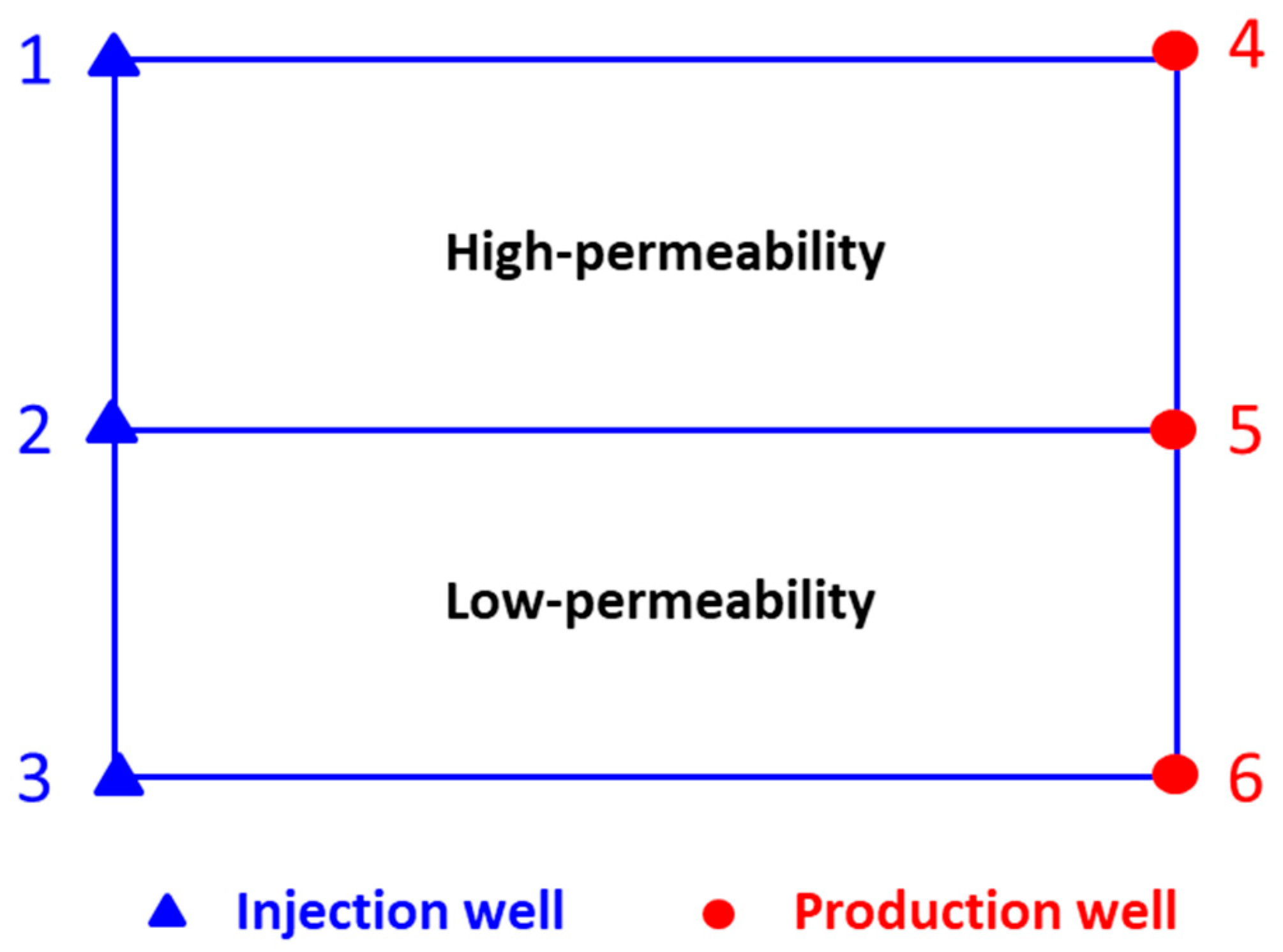
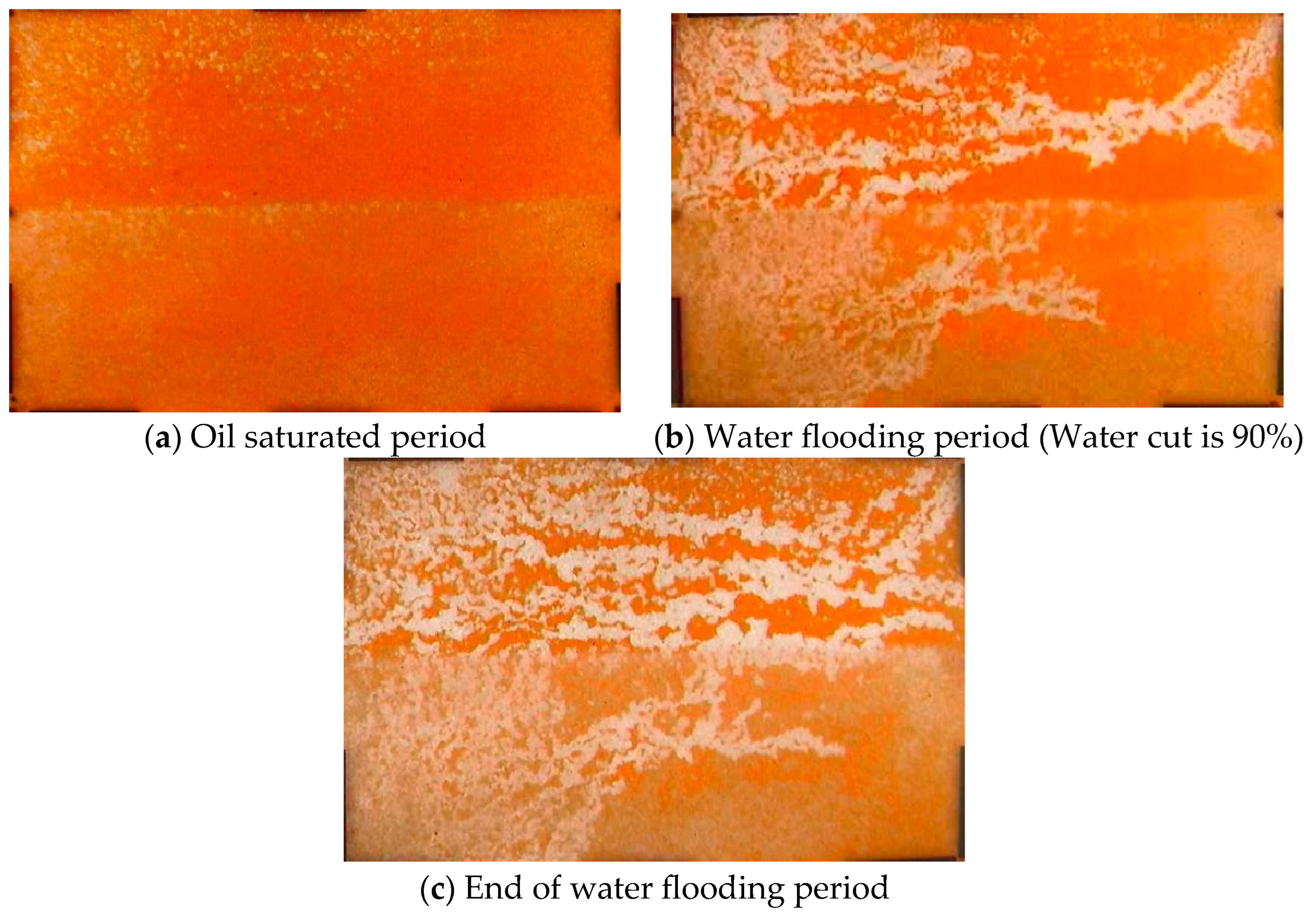

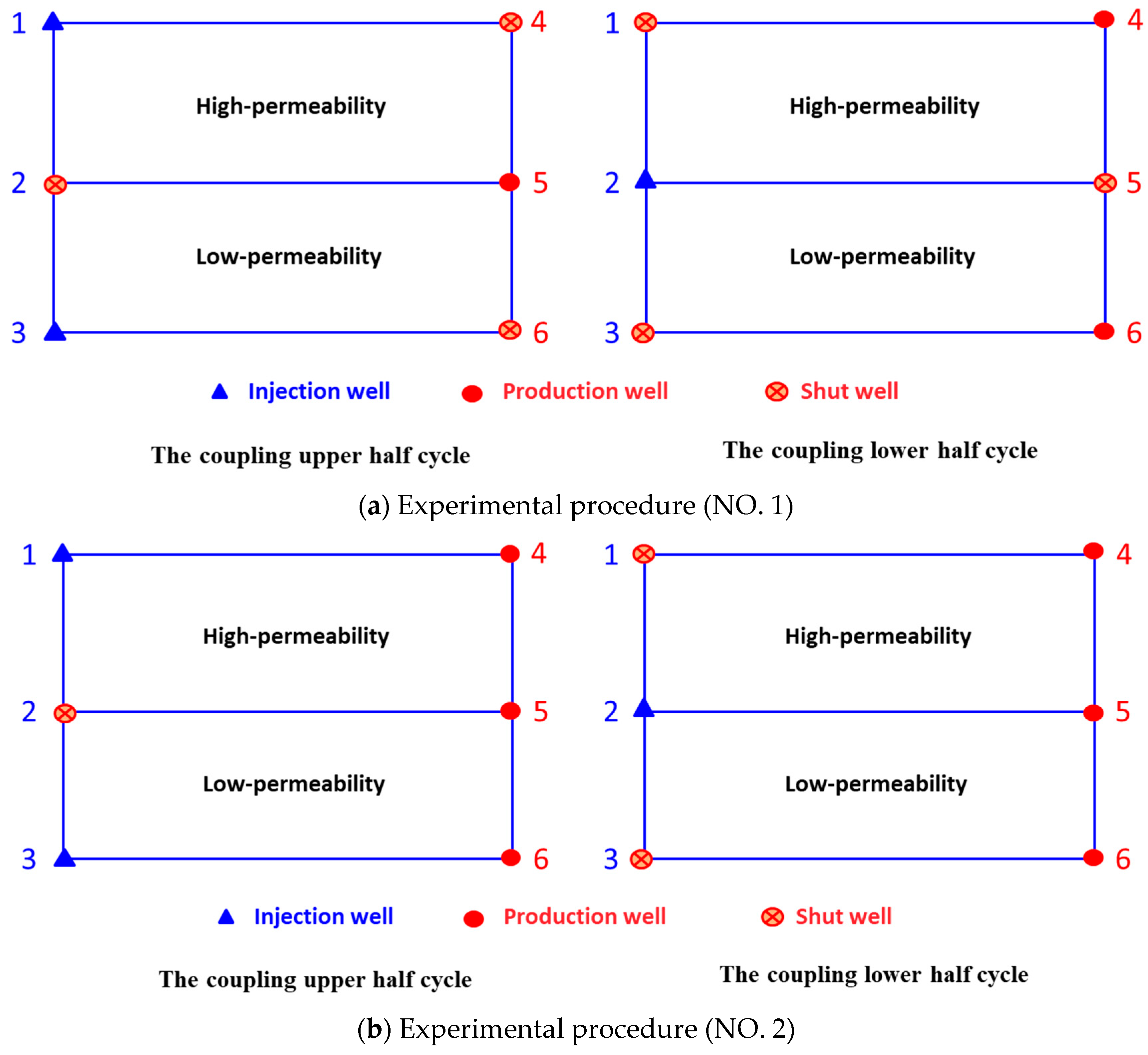
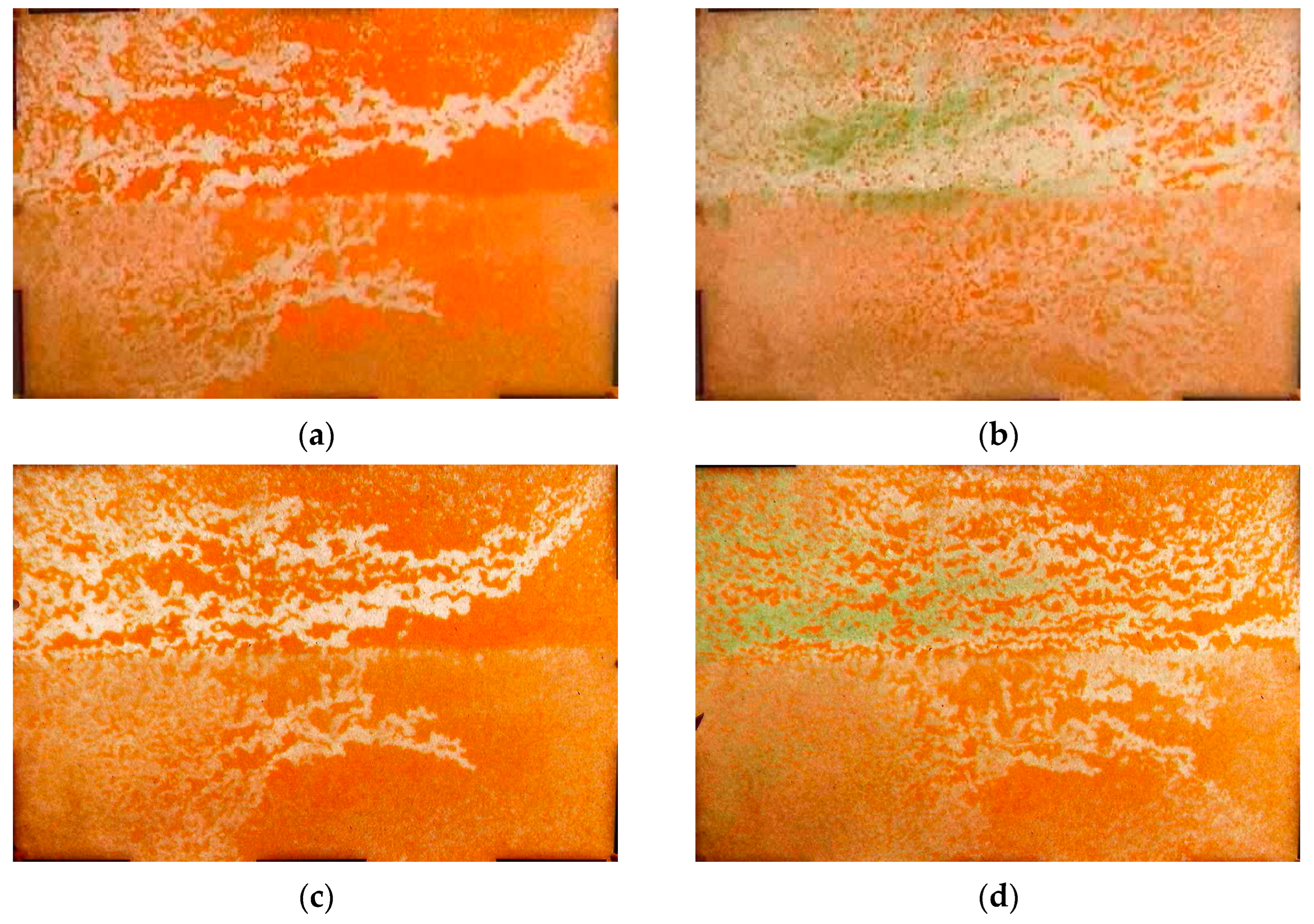


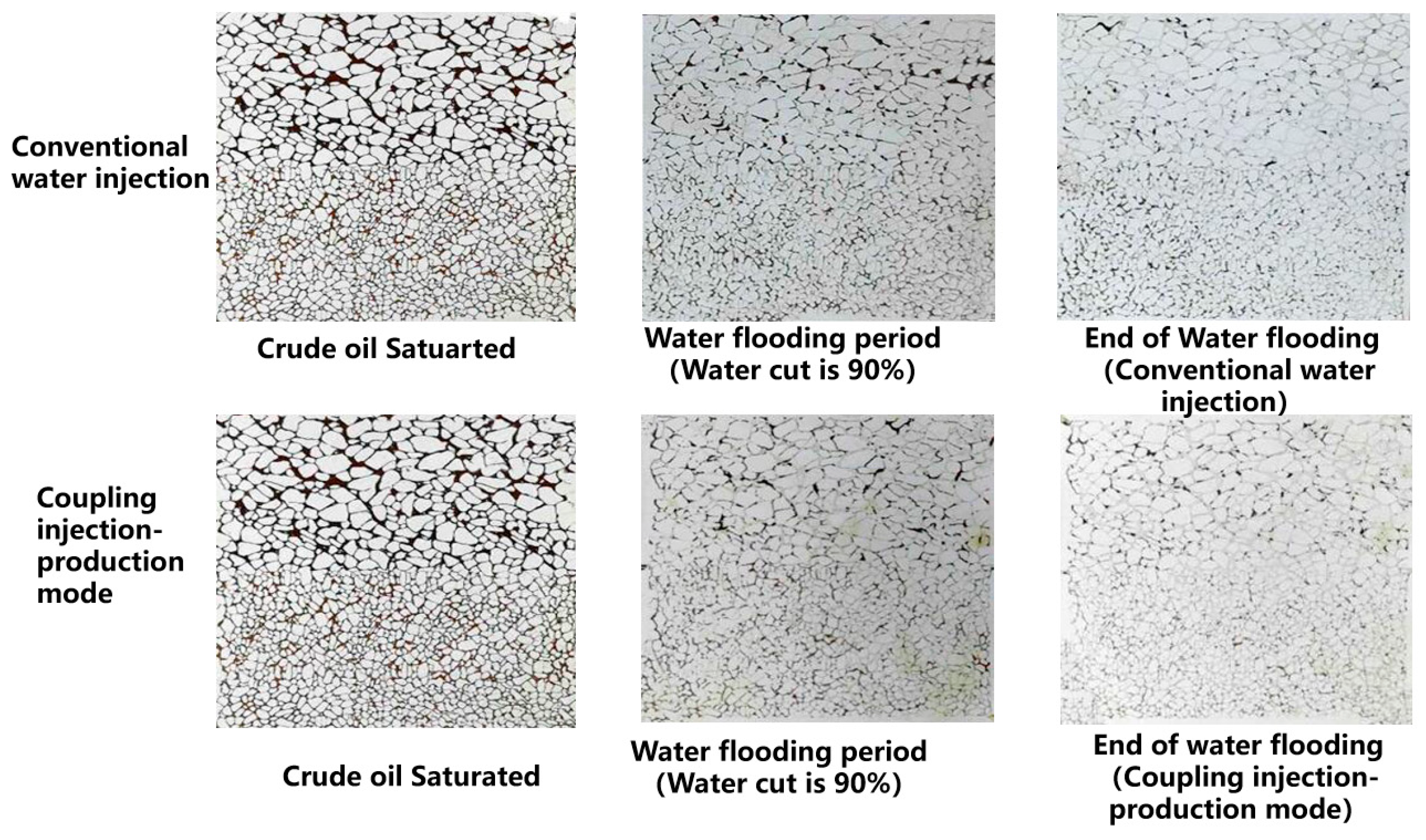
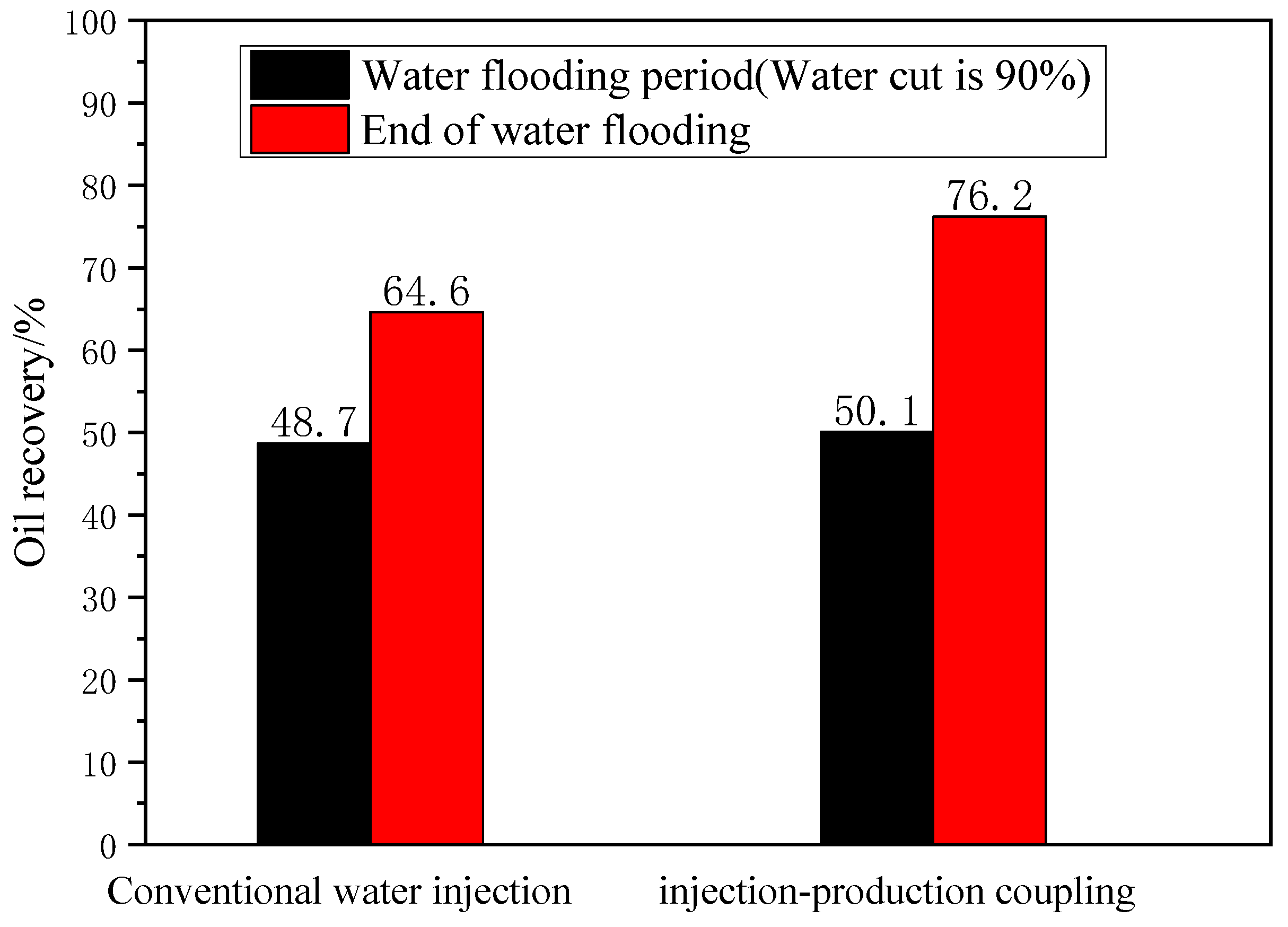
| No. | The Coupling Upper Half Cycle | The Coupling Lower Half Cycle | ||
|---|---|---|---|---|
| Injection Well | Production Well | Injection Well | Production Well | |
| 1 | Well 1#, 3# | Well 5# | Well 2# | Well 4#, 6# |
| 2 | Well 1#, 3# | Well 4#, 5#, 6# | Well 2# | Well 4#, 5#, 6# |
| No. | Oil Recovery During Initial Water Flooding/% | Oil Recovery at the End of Water Flooding Period/% | Incremental Oil Recovery/% |
|---|---|---|---|
| 1 | 40.5 | 68.2 | 27.7 |
| 2 | 42.1 | 60.4 | 18.9 |
| No. | Mode | The Coupling Upper Half Cycle | The Coupling Lower Half Cycle | ||
|---|---|---|---|---|---|
| Injection well | Oil well | Injection well | Oil well | ||
| 3 | Stop Injection mode | Well 1#, 3# (Well 2# stop injection) | Well 5# | Well 2# (Well 1# and 3# stop injection) | Well 4#, 6# |
| 4 | Reduced Injection mode | Well 1#, 2#, 3# (well 2# reduce to 1/4) | Well 5# | Well 1#, 2#, 3# (well 1# and 3# reduce to ¼) | Well 4#, 6# |
| 5 | Well 1#, 2#, 3# (well 2# reduce to 1/2) | Well 5# | Well 1#, 2#, 3# (well 1# and 3# reduce to ¼) | Well 4#, 6# | |
| No. | Mode | Oil Recovery During Initial Water Flooding/% | Oil Recovery at the End of Water Flooding Period/% | Incremental Oil Recovery/% |
|---|---|---|---|---|
| 3 | Stop injection mode | 40.5 | 68.2 | 27.7 |
| 4 | Reduced injection mode | 42.1 | 59.4 | 17.3 |
| 5 | 40.6 | 55.2 | 14.6 |
Disclaimer/Publisher’s Note: The statements, opinions and data contained in all publications are solely those of the individual author(s) and contributor(s) and not of MDPI and/or the editor(s). MDPI and/or the editor(s) disclaim responsibility for any injury to people or property resulting from any ideas, methods, instructions or products referred to in the content. |
© 2025 by the authors. Licensee MDPI, Basel, Switzerland. This article is an open access article distributed under the terms and conditions of the Creative Commons Attribution (CC BY) license (https://creativecommons.org/licenses/by/4.0/).
Share and Cite
Wang, L.; He, H.; Wu, H.; Luo, Z.; Gao, Z.; Peng, J.; Yin, H.; Lei, H. Experimental Study of Injection–Production Coupling Technique for Enhanced Oil Recovery in Mature Water Flooding Reservoirs. Processes 2025, 13, 457. https://doi.org/10.3390/pr13020457
Wang L, He H, Wu H, Luo Z, Gao Z, Peng J, Yin H, Lei H. Experimental Study of Injection–Production Coupling Technique for Enhanced Oil Recovery in Mature Water Flooding Reservoirs. Processes. 2025; 13(2):457. https://doi.org/10.3390/pr13020457
Chicago/Turabian StyleWang, Li, Hong He, Hua Wu, Zhi Luo, Zhongchen Gao, Jun Peng, Haixia Yin, and Hao Lei. 2025. "Experimental Study of Injection–Production Coupling Technique for Enhanced Oil Recovery in Mature Water Flooding Reservoirs" Processes 13, no. 2: 457. https://doi.org/10.3390/pr13020457
APA StyleWang, L., He, H., Wu, H., Luo, Z., Gao, Z., Peng, J., Yin, H., & Lei, H. (2025). Experimental Study of Injection–Production Coupling Technique for Enhanced Oil Recovery in Mature Water Flooding Reservoirs. Processes, 13(2), 457. https://doi.org/10.3390/pr13020457






